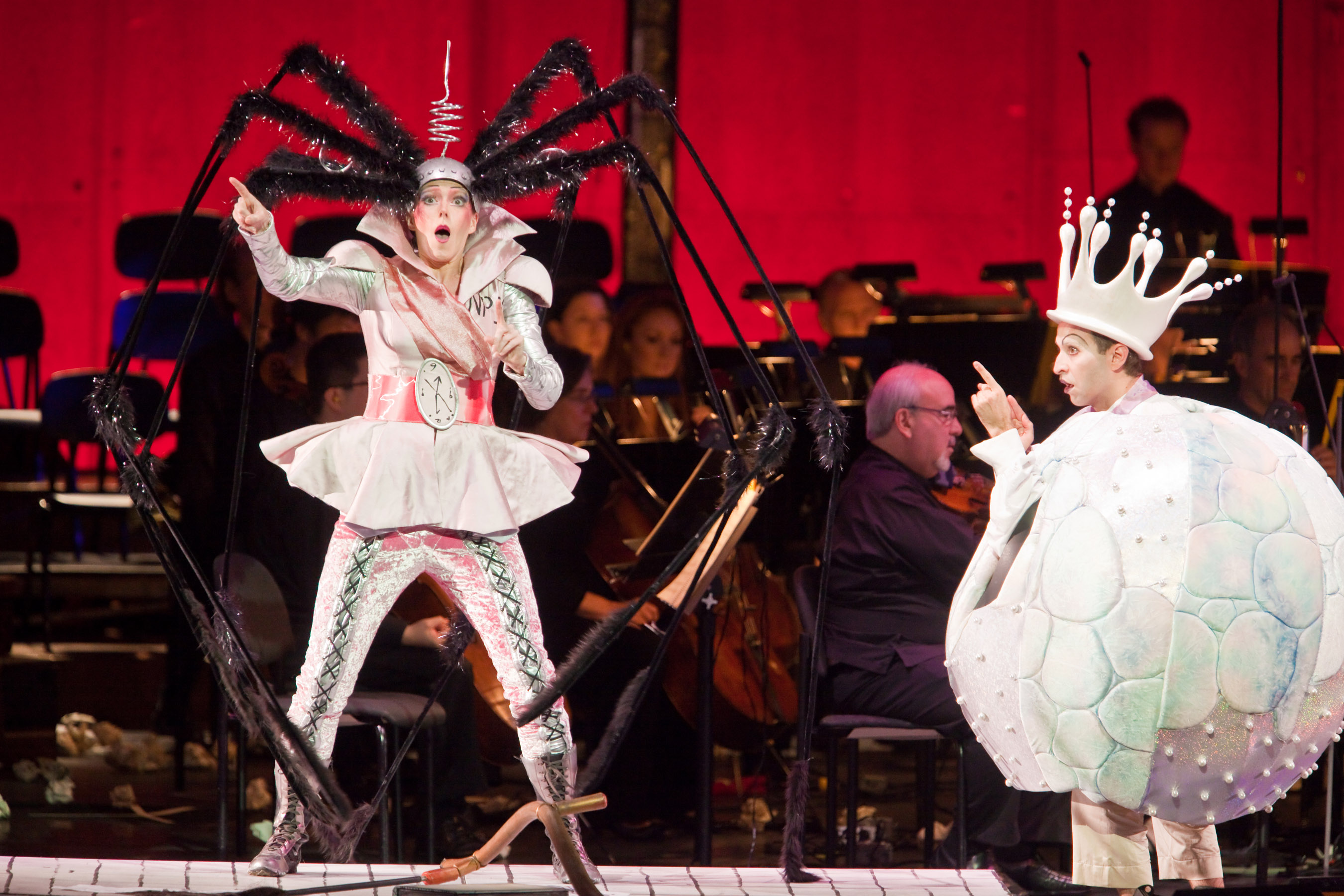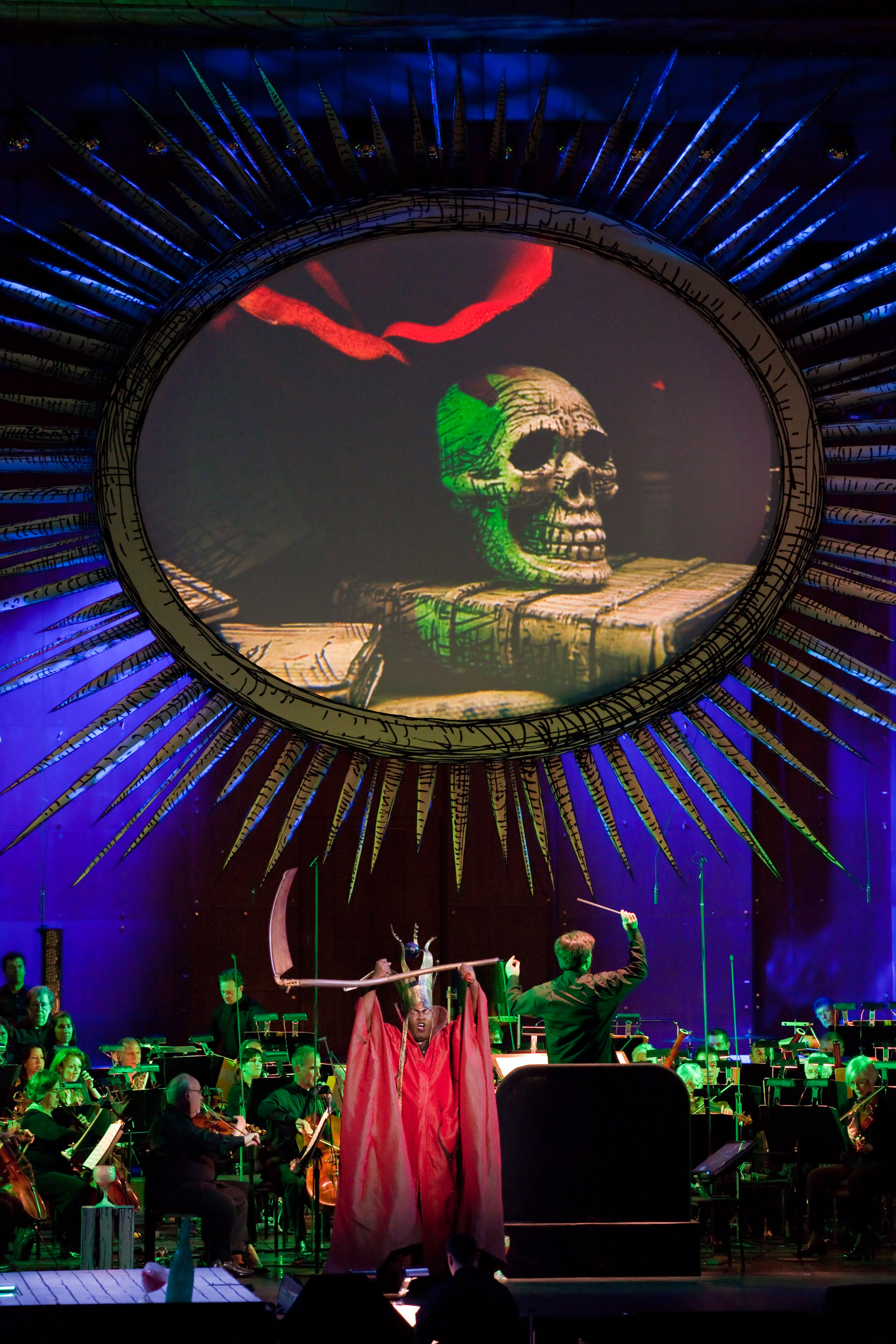In New York debut, “Le Grand Macabre” impresses as colorful show, less as music
In his first season as music director of the New York Philharmonic, Alan Gilbert has happily retained the tradition of programming an opera late in the season and demonstrated shrewdness in his chosen repertorie. Just about every major city in Europe has seen Gyorgy Ligeti’s Le Grand Macabre since it premiered in Stockholm in 1978, but until now only the San Francisco Opera has mounted it in the United States. Its New York premiere, which occurred Thursday night in the first of three performances by the Philharmonic, was long overdue.
I would have a hard time hailing Le Grand Macabre as an unalloyed masterpiece, late twentieth-century classic though it undeniably is, and the Philharmonic performance did little to change my view. Yet the opera does capture one’s interest, partly because of its sheer weirdness. And the sense of weirdness eventually gives way to fascination when, in Act 2, Le Grand Macabre at last starts yielding significant musical rewards. Like most operas, it has a literary source—a theater piece by Michel de Ghelderode, which in turn was inspired by Pieter Breughel’s painting The Triumph of Death. The opera, whose subject is nothing less than the end of the world, in fact takes place in the fictional kingdom known as Breughelland.
No real plot develops en route to the opera’s expected apocalyptic finale, but one does meet some memorable characters along the way, starting with Piet the Pot, an everyman figure and a drunk; the lovers Amanda and Amando, who when their voices are not blended in mellifluous song spend their time making love in a tomb; the astrologer Astradamors and his dominatrix wife, the whip-cracking Mescalina, who likes her men “well hung.” And Act 2 brings a new array of eccentrics.
Not content with a simple concert performance, the Philharmonic has strived valiantly to turn Avery Fisher Hall into a real opera house. Created by Giants Are Small, a company founded by Doug Fitch, who is the production’s director and designer, and Edouard Getaz, its producer, the production employs so-called “live animation” whereby characters or objects are captured on stage by a camera and projected on to a screen, here a big oval-shaped affair above the orchestra that looks like a sun emitting rays. It made for a vivid first appearance by Nekrotzar—the czar of death charged with effectuating earthly demise—when seen emerging from his tomb.

Barbara Hannigan (Gepopo) and Anthony Roth Costanzo (Prince Go-Go) in the New York Philharmonic’s production of Ligeti’s "Le Grand Macabre." Photo by Chris Lee.
But the projections are outdone by Catherine Zuber’s vivid costumes—a yellowish swallowtail coat for Piet, outlandish suits with hats out of Alice in Wonderland for the White and Black Ministers, a dark red robe and grotesque headdress for Nekrotzar, which reminded me of Falstaff in Windsor Park. (Ligeti acknowledged drawing inspiration from Verdi’s opera.) Indeed, when you add in Fitch’s energetic direction of the principals, so many elements of a full-scale production are present that a genuine stage picture tying them all together is conspicuous by its absence.
In any case, the production lacks focus. Le Grand Macabre is full of humor, of course, starting at the top with its prelude for car horns. Humor is present in abundance here, although sometimes in a way that borders uncomfortably on slapstick, as with the exaggerated antics of the two Ministers. But the opera’s subject is the end of the world, after all. Just what larger message, if any, Ligeti wanted to convey is anybody’s guess. But there ought to be some sense of a larger, cosmic dimension, which I missed.
And whose idea was it to do without supertitles? (A libretto was furnished, which was helpful, but you couldn’t read it during the performance.) Like them or not, supertitles are part of today’s operatic landscape, and audiences depend on them, especially when confronting an unfamiliar opera. (The opera was sung in Geoffrey Skelton’s English translation.)
Fortunately, things were in fine shape musically, with Gilbert leading a rhythmically exact, well ordered performance. It’s hard to get much of a hold on Act 1 musically, despite an effective closing ensemble; indeed as much of the text there seems to be spoken as sung. But not long into Act 2 comes a big piece labeled “Collage” constructed on a distorted version of the bass line of the finale of Beethoven’s Third Symphony, and Gilbert brings out the riotous cacophony of the instrumental parts above.
Another choice piece is the extended “alcoholic trio” for Astradamors, Piet and Nekrotzar, which has an especially telling moment when solo strings briefly take over in a dreamy mood. But the high point is saved for the close, when the end of the world doesn’t materialize after all; instead we hear an ethereal, tonally lush passacaglia, which Gilbert ensured registered in all its serene beauty.
Eric Owens was a formidable vocal and physical presence as Nekrotzar. Mark Schowalter brought a bright tenor voice, interpretive finesse and fine diction to the role of Piet. Jennifer Black and Renée Tatum sang alluringly as Amanda and Amando. Melissa Parks and Wilbur Pauley made quite a couple as Mescalina and Astradamors. Anthony Roth Costanzo’s countertenor voice served handily in Prince Go-Go’s music, and Barbara Hannigan was astonishing as Gepopo, a role that takes her into the vocal stratosphere.
New York has finally caught up with Le Grand Macabre. But there is more to the opera than was readily apparent at the Philharmonic.
Le Grand Macabre will be repeated 8 p.m. Friday and 8 p.m. Saturday. www.nyphil.org; 212-875-5656.

Posted May 29, 2010 at 9:05 am by matthew gurewitsch
The costumes were noit by Doug Fitch but by Catherine Zuber.